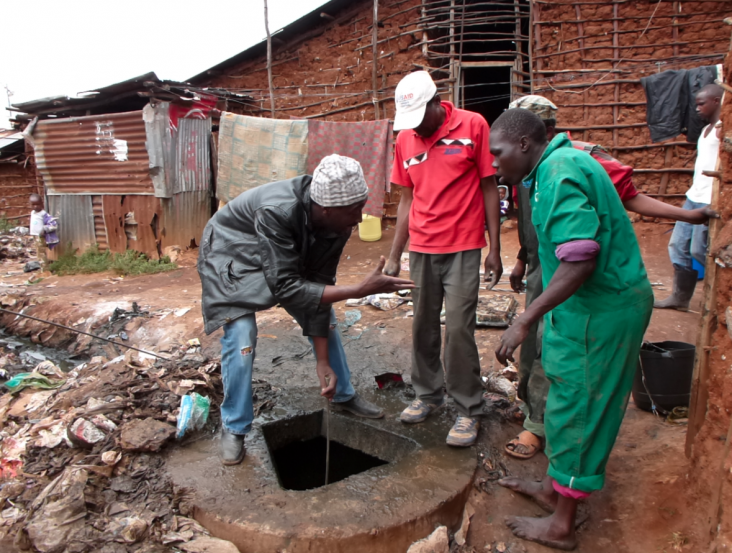
Every second, two people are added to cities around the world.
This population surge is particularly rapid in sub-Saharan Africa. The region has the largest urban growth rate in the world, with populations increasing 5 percent annually. In some cities, the annual growth rate exceeds 10 percent. These populations are projected to double within the next decade.
The majority of sub-Saharan Africa’s 400 million city-dwellers live in slums with high population density and poor municipal services. They often lack access to clean water and safe sanitation. Under these conditions, waterborne diseases spread rapidly. In the Kibera settlement of Nairobi, Africa’s largest slum, more than 18 percent of children die before their 5th birthday.
USAID launched the African Cities for the Future (ACF) program in Kumasi, Ghana; Bamako, Mali; Antananarivo, Madagascar; Maputo, Mozambique; and Nairobi and Naivasha, Kenya to help cities meet this urgent and ever-growing need for improved water, sanitation, and hygiene (WASH).
Combining Forces
Because improving urban WASH necessitates navigating complex webs of stakeholders, USAID chose Water & Sanitation for the Urban Poor (WSUP) to implement ACF. WSUP is a non-profit multi-sector partnership that brings together the private sector, NGOs, and academia to focus on bringing WASH to low-income urban residents.
“Partnerships were really core to this program and a key to its success,” said Andy Narracott, ACF Chief of Party.
WSUP forged connections in each city with diverse groups – from utilities and landlords to houses of worship and schools. This was not easy, as these stakeholders are often underfunded and overextended. To incentivize participation, the program carefully defined roles and ensured there was accountability on both sides of each partnership.
The program built the capacity of service providers and utilities to reach slums, map water points, reduce non-revenue water, and generally expand and improve services. They worked with landlords and schools to upgrade sanitation facilities. In cooperation with local governments, ACF introduced water kiosks, low-cost sewerage systems for slums, and sanitation blocks. The program also trained community-based organizations in fecal sludge management so they could provide this much-needed service in cities.
Some of the partnerships were unconventional. In order to promote hygiene in low-income schools in Kenya, ACF collaborated with Unilever. They conducted traditional market research and launched a WASH advertising campaign based on their findings. The campaign consisted of jingles, posters, and other advertising materials that portrayed handwashing with soap and other hygiene behaviors as clean, modern, and even aspirational.
Collaborating With Communities
In order to make a real difference in the long-term though, the program needed community buy-in.
ACF trained community members to maintain WASH infrastructure and taught local artisans to construct latrines. In Kumasi, ACF helped form a Community Management Committee, comprised of members nominated by traditional rulers, women’s groups, the youth group, and other influential locals. The Committee worked with the utility to operate the decentralized water supply system and brought together their neighbors for a community cleanup campaign.
“We work with communities to be accountable,” said Mr. Narracott. “Community ownership is key to sustainability.”
To this end, ACF consulted community members when planning infrastructure. In Naivasha, it held toilet design clinics, which are structured like focus groups but include engineers and project planners, to enable members of underserved groups to articulate their sanitation needs. The goal of the clinics was to learn how to build better latrines that communities would actually use.
At the clinics, it became clear that community members did indeed want the toilets. “My wish has been to have and use a toilet that is permanent before I die,” said one clinic participant, Milka, a community elder from Naivasha, Kenya.
But many said there were barriers to using them. Children said they avoid toilets due to fear of falling into them. People with disabilities and the elderly said that it was difficult to squat on them due to physical constraints. Women said the threat of sexual assault prevented them from using mixed-sex facilities. And all groups stated the need for cleaner facilities with shorter lines.
Project staff documented the community input and came up with replicable solutions to ensure the toilets would actually be used, such as making smaller, more child-friendly toilets connected to bathhouses with separate sections for men and women.
“The poor are not needy, helpless people. They are customers,” said Mr. Narracott.
Replicating Successes
WSUP has produced a series of publicly available documents based on these and other lessons learned from ACF. These include a guide on how to implement effective urban pro-poor WASH programs, a practice note on the gender-inclusive approach to communal sanitation, and a discussion paper on financing WASH improvements for the extreme poor.
From 2009 to 2014, ACF improved WASH for more than half a million people in Africa. While the program ended in September, utilities throughout the region are now working to replicate and scale up initiatives, such as low-cost sewerage, on their own.
According to Mr. Narracott, this is the true mark of ACF’s success. “We want people to see this program and say, ‘I want to try this somewhere else.’”
C. Zeilberger







Comment
Make a general inquiry or suggest an improvement.